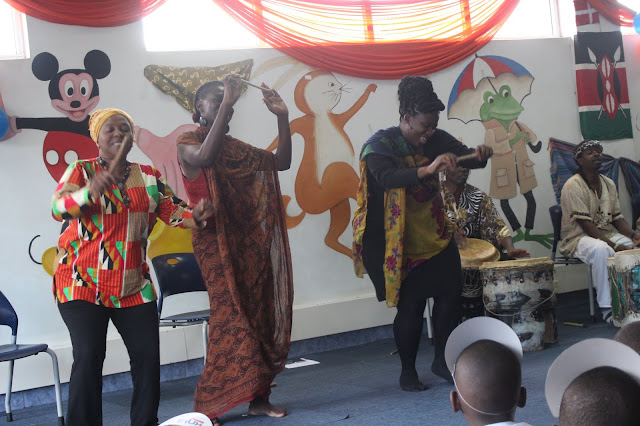By
Margaretta wa Gacheru (Posted 30 May 2018 for Business Daily)
Theatre is
all about storytelling, which is why we love to go see comedies like
Heartstring’s ‘Tit for tat’ which opened at Alliance Francaise last night, and
love stories like Legacy Arts’ ‘Love Contract’ opening tonight at Kenya
National theatre as well as ‘Constellations’ premiering in Kenya next week at
Braeburn theatre.
But then,
there’s a special genre of solo artists who are exclusively ‘storytellers’.
These are individuals who usually are incredibly charismatic as well as being
dramatic, eloquent. And if they are really good at their craft, they can be so
spell-binding that they carry you, by their spinning intricate webs of words mixed
with loquacious body language, into other worlds.
If you don’t
believe me, just head to Dream Kona inside Uhuru Gardens tomorrow, 2nd
June, from 10am when Zamaleo Arts presents the Sigana International
Storytelling Festival. It’s the largest such festival ever presented in Kenya.
Featuring storytellers from Tanzania and Uganda as well as from Kenya, South
Africa and India, performances already began earlier this week. What’s more,
theirs is a traveling festival that will be staged in venues around Nairobi and
Kiambu as well as in Tala, Kisii and Siaya County.
The grand
opening of the festival was last Tuesday at the Buru Buru branch of the Kenya
National Library. It was a perfect location since this relatively new library
(opened in 2010) has a large performance space upstairs. There was even plenty
of room for the multitude of Nairobi school children who came by the bus-load
and quickly were charmed by Alumbe Helen into doing a slew of ‘warm-up’
exercises and having heaps of fun in the process.
But don’t imagine
this storytelling fest is only for children. All the performing artists (for
that is what storytellers are) have a vast repertoire of stories to share, one
for every occasion. Last Tuesday in the Library, the occasion called for tales
that could charm children by sharing stories that also taught moral lessons.
But all the artists are trained to be adaptable according to their audience,
which on Tuesday was children. But then yesterday, when the festival went to
the ‘artists’ colony’ at Karen Village, performances were oriented more toward
appealing to adults and fellow artists.
By Tuesday,
not all the storytellers had arrived. But that didn’t stop the show going on.
After Alumbe’s ‘warm up’ and getting all the children (none of whom were above
eight years old, I believe) actively engaged in the process of communicating
with their whole bodies and minds, the show officially started.
With drummers
Joseph Manzi, Saul Muthoka and John Namai setting the rhythm and providing all
the essential sound-effects to each professional storyteller’s African tale,
the first up was Baeletsi Tsatsi, from Johannesburg. Her fellow South Africans
Bongiswa and Sizwe were still on their way, but no matter. Baeletsi shared a
marvelous story about The Sky Maiden and the Frog and got children chiming in
when this Market Theatre-trained actress signaled that they do so.
She was
followed by Christa Komba from Tanzania who’d devised an original Swahili tale
that the army of school children clearly enjoyed. Both she and Baeletsi have a
penchant for ‘applied theatre’ which is how they got into storytelling.
Meanwhile, Christa also teaches at the Bagamoyo Institute of Dramatic Arts.
On Saturday,
the Festival will move over to Dream Kona where all the storytellers will perform
according to the theme recommended by the creators of the new performing and
visual arts space, TICAH (Trust for Indigenous Culture and Health).
“We will be
celebrating World Environment Day two days early,” says Alumbe who adds that at
least 75 percent of the storytelling will be related to protecting and
preserving Mother Earth. They may also explore the issue of waste management,
particularly related to plastics which have become so detrimental to life on
both land and sea.
Sigana
Storytellers Alumbe and John Mukeni have also shared the stage with their
late-arriving artists, including Patricia Xoey from Uganda, Sherin Matthews and
Seema both from India, and Bongiswa and Sizwe from South Africa.
The Festival
will run through 9th June. For bookings, schools and individuals can
still email at info@zamaleoact.org
or call 0722739894.
Meanwhile,
at Kenya National Theatre for two days only, the original script by Jean
Akinyi, ‘Contract Love’ will be staged, directed by Dr Zippy Okoth. It stars Suki
Wanza, Papi Odeq, Sue Makena and Vitalis Wesh. Described as an ‘African love
fantasy’ the show combines music, dance and drama and should provide a
sumptuous theatrical experience.















































